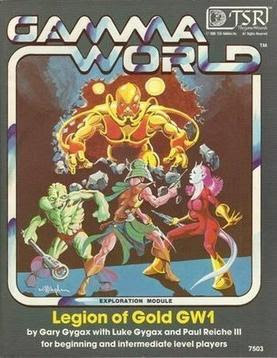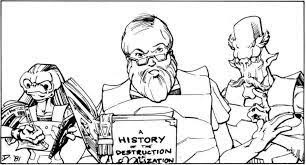The Setting of Gamma World (Part III)
 I've written before about Legion of Gold and my love for it, so I will do my best to avoid gushing about it in this post. Instead, I want to focus on what the module – the first full-length one to be published for Gamma World and by Gary Gygax no less – says about the game's setting and how this information jibes with what is stated or implied elsewhere.
I've written before about Legion of Gold and my love for it, so I will do my best to avoid gushing about it in this post. Instead, I want to focus on what the module – the first full-length one to be published for Gamma World and by Gary Gygax no less – says about the game's setting and how this information jibes with what is stated or implied elsewhere.
When I talk about Legion of Gold, I sometimes compare it to another Gygax-penned adventure module, The Keep on the Borderlands, even though the comparison is not exact. In both, the player characters have a "home base" – the titular Keep in B2 and the City of Horn in Legion of Gold – from which they can launch their exploration of the surrounding areas. Where they differ is that, while the D&D module is set in a "true" wilderness far from the borders of civilization, its Gamma World equivalent takes place in a region whose relative stability is being disrupted by the incursions of a terrible new enemy.
The very existence of the City of Horn and of more than a dozen other settlements within the larger Barony of Horn shows – quite reasonably in my opinion – that, 150 years after the End, civilization has been re-established, albeit on a quasi-medieval model, both socially and technologically. This is in contrast to the common assumption among many players that the post-apocalyptic Earth of Gamma World is a wasteland peopled entirely by primitive tribes. I can somewhat understand the origins of this assumption. Many GW adventures, like Famine in Far-Go, which I'll discuss in the next post in this series, start off with the characters being members of such a tribe about to embark on their first foray outside their traditional tribal lands. That's a perfect kick-off to a campaign, but it's not the only possible one. One of the many reasons I like Legion of Gold is that it presents another possibility.
Though the Barony of Horn is modeled on a walled medieval city, it's not entirely devoid of Ancient technology. Indeed, Baron Jemmas has a stockpile of high-tech weapons and vehicles in his possession, some of which he gives to his elite soldiers to employ in defense of Horn. This situation makes eminent sense to me, since there are probably a lot of Ancient devices lying around and possession of them would give one a significant advantage over one's enemies. In any case, Legion of Gold makes it very clear that human civilization is already in the process of rebuilding. The characters should thus not be surprised to encounter law and order of a rough sort in many regions, though obviously nothing as sophisticated as what was found prior to the End.
Throughout the module, there are occasionally references to historical events from the past. These events all take place in our own future, but they're consistent with what's implied elsewhere about the game's setting. Thus, we see mention of "a period of cold war between 2150 and 2193," during which time "the rapid advancement of beam and robotic weaponry was constantly shifting the balance of power," as well as an underwater research facility established in 2284 by order of the "Secretary of Technological Advancement" of the United States of America. Furthermore, free willed androids act as antagonists during one portion of the adventure and the Legion of Gold itself is the work of a rogue "control computer" with the ominous name of REAPER. There is thus no mistaking the fact that, as presented by Legion of Gold, Gamma World takes place in a world several centuries hence.
Nevertheless, some of the problems I commented upon on Part I of this series remain in evidence. Included among the new weapons are things like rifled muskets and shotguns that arguably shouldn't have existed into the 24th century. The module's text seems to recognize this issue and attempts to justify them as having "persisted for purposes of target shooting, hunting, and self-protection." Of more concern (to me anyway) are the additional items offered up as random treasure, like plastic cutlery, can openers, telephone books, and even polyhedral dice. As before, they seem to be simply examples of meta-humor by Gygax and his co-authors rather than anything intended to undermine Gamma World's setting, but I dislike them nonetheless.
Like "The Albuquerque Starport," Legion of Gold largely comports with the idea that the game is set after the fall of a high-tech society several centuries in advance of our own. More important, I think, is that it's the first time we're offered a glimpse of any kind about the setting's "Big Picture." What are the surviving descendants of that high-tech future doing a century and a half later? How have they organized themselves? What do they know about the past and to what extent do they make use of the devices of the Ancients? These are questions that Gamma World had never answered before. Even if you take issue with the answers Gygax and company offered – though I personally like them – I find it difficult not to be pleased that they made an effort at all. Therefore, what Legion of Gold really provides is a sense of what the setting of Gamma World is like (or may be like) in its present, not just its past. That's not nothing and, I would argue, gives prospective players and referees a helpful model to inspire their own campaigns.

James Maliszewski's Blog
- James Maliszewski's profile
- 3 followers



